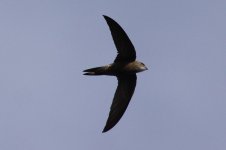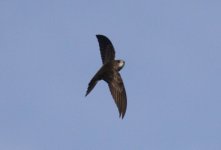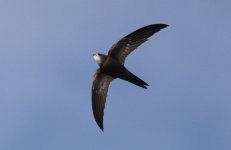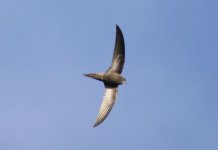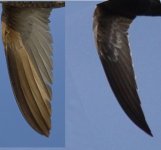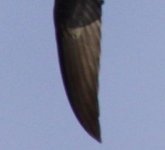-
Welcome to BirdForum, the internet's largest birding community with thousands of members from all over the world. The forums are dedicated to wild birds, birding, binoculars and equipment and all that goes with it.
Please register for an account to take part in the discussions in the forum, post your pictures in the gallery and more.
You are using an out of date browser. It may not display this or other websites correctly.
You should upgrade or use an alternative browser.
You should upgrade or use an alternative browser.
Swift ID Whitburn Co.Durham (1 Viewer)
- Thread starter Adam W
- Start date
More options
Who Replied?Jane Turner
Well-known member
Well I'll argue a bit - I'm not sure I can see pale bases - I can see shadows
I'm fairly sure i'm not sure about being sure any more about feather edges/tips/lighting etc....[tricky ain't it]...? 
Seriousy tho...it certainly seems to lack pale edges...but whether or not the apparent pale bases are true...or just shadow...wellll....?
http://username-beast.blogspot.com/
Seriousy tho...it certainly seems to lack pale edges...but whether or not the apparent pale bases are true...or just shadow...wellll....?
http://username-beast.blogspot.com/
duncan fraser
Well-known member
I also think this is a Common Swift.
Some pekinensis for comparison...
http://4.bp.blogspot.com/_OnUjkhRdV...16dqXh09HRQ/s1600/pekinensis+Common+Swift.jpg
http://www.israbirding.com/reports/..._visit_feb-08/pekinensis_swift_ShirihaiC_.jpg
A useful comparison between Common and Pallid here...
Common
http://www.pbase.com/dophoto/rondone
Pallid
http://www.pbase.com/dophoto/rondonepallido&page=all
ps My avatar was put up 2 weeks ago. Pure coincidence!
Looking at the photos of Pallid, they show no resemblence to the bird at Whitburn. The Whitburn bird is far too dark, the wings are too pointed and the shape of the body is too narrow. I watched what was probably the same bird (it had the same throat and underwing pattern) at Chourdon Point two days ago for abot 20-30 minutes. It flew like a Common Swift and at no point did its flight action or behaviour seem like a Pallid Swift ( I watched several dozen this summer in Portugal). For me it is just a juvenile Common Swift
Brett Richards
Well-known member

A heavy crop that i reckon shows pale bases not tips to the belly feathers though what that actually means reguards ID I wouldnt personally know.
These certainly look like pale bases rather than pale tips, but in this case where are the pale tips? Worn off?
Still confused.
Brett
Silly Bustard
Active member
Swifts like these turn up every year in late autumn and get us all going. Me and some friends had a swift on the 1st of November at LBO in 2008. The general consensus was pallid, but it never got anywhere due to some doubts. After consulting someone with a lot more knowledge than i have, i was told that Common swift from more easterly regions tend to show the features of the swift in the photo, ie the pale scallops on the belly, more extensive white on the face. The strange thing about our bird was the slow flight with very long glides, but the very cold temperatures may have been to blame for this!
Alan Tilmouth
Well-known member
Thanks for posting the additional images Adam ( and thanks for the PDF Ross). This one has filled in a couple of hours, earlier in the evening if pushed I'd have come down on the side of Common but after much reading I seem to be seeing some features that taken together may point to Pallid.
In addition to the point already made by Ross I see the following:
- apparent contrast between mantle and hindneck (visible in that 2nd batch of shots).
- throat patch and forehead colour fading with poorly defined rather than sharp border
- pale edges on underwing median coverts
However, the overall colour bothers me as on my monitor it looks darker than I might of expected of a juvenile Pallid, though if Ross is correct (and I have no reason to doubt him) about the diagnostic nature of the pale bases to the belly feathers could this be brehmorum (Western Med) as opposed to pallidus?
I'd just add a note of caution with the words of the great prophet Matinganner a few years back on this subject
"There does not seem to be a single diagnostic character."
"The appearance of swifts in the field can vary enormously even on a single bird. They are amongst the most mobile birds on the British list, and therefore the most difficult on which to see cryptic identification features. Also, despite comments following previous records, there is still a lack of awareness of the appearance of juvenile Common Swifts and the distinct possibility of the presence of Asian Common Swifts masquerading as vagrant Pallid Swifts."
In addition to the point already made by Ross I see the following:
- apparent contrast between mantle and hindneck (visible in that 2nd batch of shots).
- throat patch and forehead colour fading with poorly defined rather than sharp border
- pale edges on underwing median coverts
However, the overall colour bothers me as on my monitor it looks darker than I might of expected of a juvenile Pallid, though if Ross is correct (and I have no reason to doubt him) about the diagnostic nature of the pale bases to the belly feathers could this be brehmorum (Western Med) as opposed to pallidus?
I'd just add a note of caution with the words of the great prophet Matinganner a few years back on this subject
"There does not seem to be a single diagnostic character."
"The appearance of swifts in the field can vary enormously even on a single bird. They are amongst the most mobile birds on the British list, and therefore the most difficult on which to see cryptic identification features. Also, despite comments following previous records, there is still a lack of awareness of the appearance of juvenile Common Swifts and the distinct possibility of the presence of Asian Common Swifts masquerading as vagrant Pallid Swifts."
Last edited:
Jane Turner
Well-known member
For me the biggest worry for this bird is its structure.
Adam W
Well-known member
The strange thing about our bird was the slow flight with very long glides, but the very cold temperatures may have been to blame for this!
This bird seemed to be a bit that way too hence the reason i was able to get what are probably the best photo's ive taken of any Swift and thats not for the want of trying the last two summers, It certainly wasnt very cold today but then i suppose it might be compared to mid summer.
I should add i have no idea at all of the differences in flight action between Common and Pallid but i do remeber thinking at the time that i was suprised how relatively easy this bird was to photograph(perhaps due to slower flight and more gliding) compared to the many other Swifts ive tried and failed miserably to sucessfully photograph.
Alan Tilmouth
Well-known member
For me the biggest worry for this bird is its structure.
Specifically?
Alan Tilmouth
Well-known member
This bird seemed to be a bit that way too hence the reason i was able to get what are probably the best photo's ive taken of any Swift and thats not for the want of trying the last two summers, It certainly wasnt very cold today but then i suppose it might be compared to mid summer.
I should add i have no idea at all of the differences in flight action between Common and Pallid but i do remeber thinking at the time that i was suprised how relatively easy this bird was to photograph(perhaps due to slower flight and more gliding) compared to the many other Swifts ive tried and failed miserably to sucessfully photograph.
Back in 2006 James Gilroy made the following comments (on the birdguides webzine ID article) in relation to this point:
"I’m also very sceptical about using flight-style as an id-pointer, simply because flight action may depend on the condition of the bird. Any swift in northern Europe in November is likely to be pretty weak and hungry, and this may contribute to the flappy, slow flight style that some of them show."
I can't add anything but it certainly seems plausible.
Jane Turner
Well-known member
Specifically?
the wing tip shape is the thing that is most obvious in the photos - you'd really want it to look like this
http://www.pbase.com/dophoto/image/102393979
Attachments
Last edited:
Alan Tilmouth
Well-known member
the wing tip shape is the thing that is most obvious in the photos - you'd really want it to look like this
http://www.pbase.com/dophoto/image/102393979
Allegedly, though you could just as easily have posted this or this (from the same gallery) (hi by the way hope you're well)
Alan Tilmouth
Well-known member
lewis20126
Well-known member
Juvenile Common Swift for me; as others have said, this is surely far too dark above for the rarer bird.
cheers, a
cheers, a
Alan Tilmouth
Well-known member
Juvenile Common Swift for me; as others have said, this is surely far too dark above for the rarer bird.
cheers, a
I've an open mind on that, this monitor has tripped me up before, this doesn't seem too far away though (and presumably taken in brighter light)
Barred Wobbler
Well-known member
I've tried making it pallid, but I can't.
Not 'hippy' enough. Wing shape - even allowing for the vagaries of the camera, some shots should have been at an angle to show the broader wing on so many images. Lack of contrast in the primaries. Not enough 'mask'.
I hate swifts. When I'm away I can't wait to see the first nailed-on pallid and the first nailed on common, then I can forget about the rest (unless they are showing white on the rump, then I'll sit up).
Not 'hippy' enough. Wing shape - even allowing for the vagaries of the camera, some shots should have been at an angle to show the broader wing on so many images. Lack of contrast in the primaries. Not enough 'mask'.
I hate swifts. When I'm away I can't wait to see the first nailed-on pallid and the first nailed on common, then I can forget about the rest (unless they are showing white on the rump, then I'll sit up).
Alan Tilmouth
Well-known member
I wouldn't normally quote the competition but I note that RBA have just added their daily summary that reads "the only new rarity today was a smart Pallid Swift at Whitburn" 
KenM
Well-known member
Juvenile Common Swift for me; as others have said, this is surely far too dark above for the rarer bird.
cheers, a
Back in '82 (May, I had a Pallid Swift with c20 Common Swift to compare against, it was Sand Martin brown v Sooty brown Common Swift...stuck out like a sore thumb! large white throat patch,(when no throat patch was visible on Apus apus), darker saddle, darker outer prims.contrasting against inner etc.etc. It was not accepted...because I didn't see the body scalloping, darker ear coverts, or rounded tips to the prims. (I would have had difficulty at 400m.. looking through a pair of 10x42's). Many years later, I saw the Spring Cliffe (North Kent) bird, and recently the Kessingland bird, both of which I found much..much darker, than my original bird..How variable are Pallid across their range?
cheers
phil baber
Clipped Wing

Back in '82 (May, I had a Pallid Swift with c20 Common Swift to compare against, it was Sand Martin brown v Sooty brown Common Swift...stuck out like a sore thumb! large white throat patch,(when no throat patch was visible on Apus apus), darker saddle, darker outer prims.contrasting against inner etc.etc. It was not accepted...because I didn't see the body scalloping, darker ear coverts, or rounded tips to the prims. (I would have had difficulty at 400m.. looking through a pair of 10x42's). Many years later, I saw the Spring Cliffe (North Kent) bird, and recently the Kessingland bird, both of which I found much..much darker, than my original bird..How variable are Pallid across their range?
cheers
Nice point Ken, and something that has been missed in this discussion: the overall coloration.
Spent 2 weeks on Menorca and Portugal this year comparing the 2.
I described it as "milky-brown". Though one could say " Toffee Brown", "Creamy Tea", or similar for Pallid. When you catch them in the right light, it's the ground colour that strikes you most. So much so, that it's a revelation.
They were not named "Pallid" for no reason!
Anyone with experience of Pallid and Common, occuring together in a region, will know how difficult they are to separate. Unless one gets views in the right light, and that is crucial in my experience. It is one of those birds that will always demand the grace of a certain view, in certain light, to see it as it really is.
Both species Tazz around like Dervishes, and can often be inseperable when doing so. To get such good photos of the thread's subject bird is key I feel. It is too dark for a Pallid. Too sharp-winged. Amongst other things.
I've held 2 Common Swifts in my life. You'd be surprised what you can see on the plumage in the hand...
I, again, refer you to this excellent suite of photos that, for me, show what a Pallid looks like in reality...
http://www.pbase.com/dophoto/rondonepallido&page=all
Compare and contrast with the subject-bird photos. The Devil's not always in the details, but often in the overall bird itself...
With good views, in the right light conditions, I was a convert to the 2 species theory! Crikey! And then some!
ps The photos are superb Adam! You should be well-proud of yourself!:t:
Last edited:
Similar threads
- Replies
- 4
- Views
- 765
Users who are viewing this thread
Total: 2 (members: 0, guests: 2)




